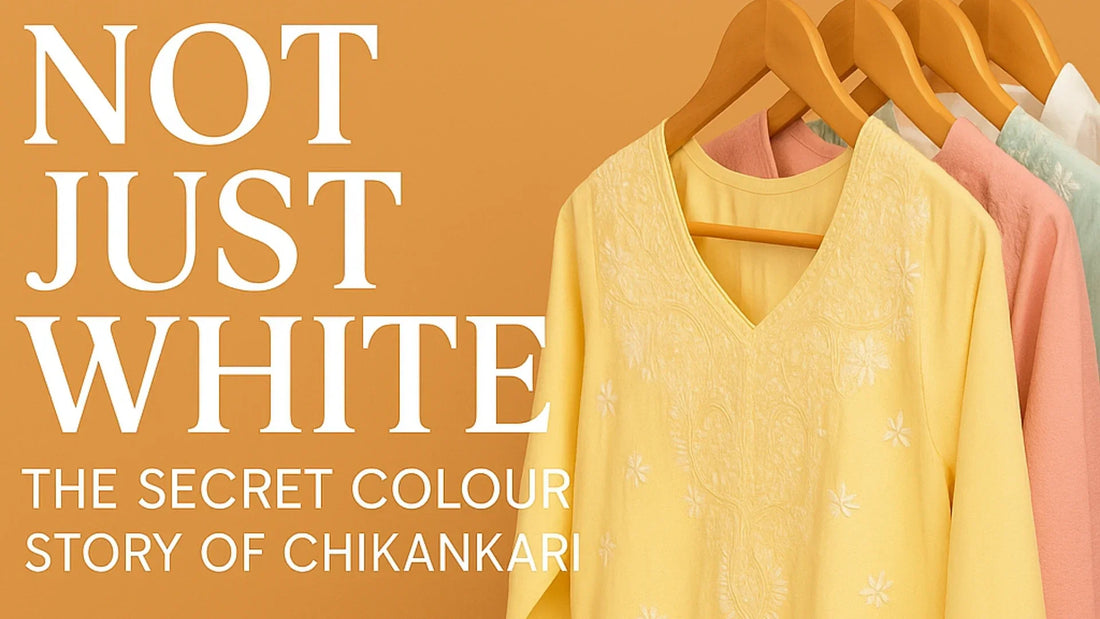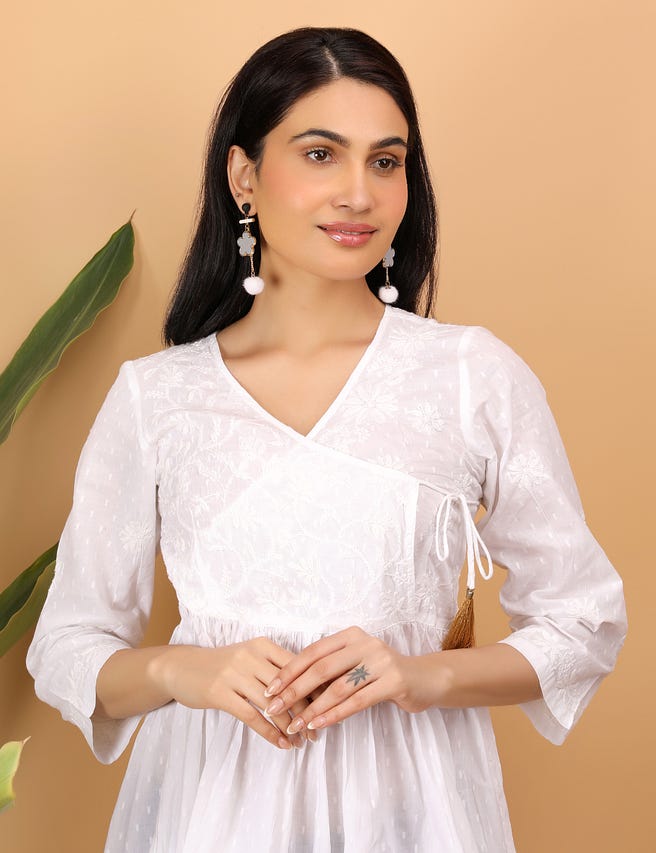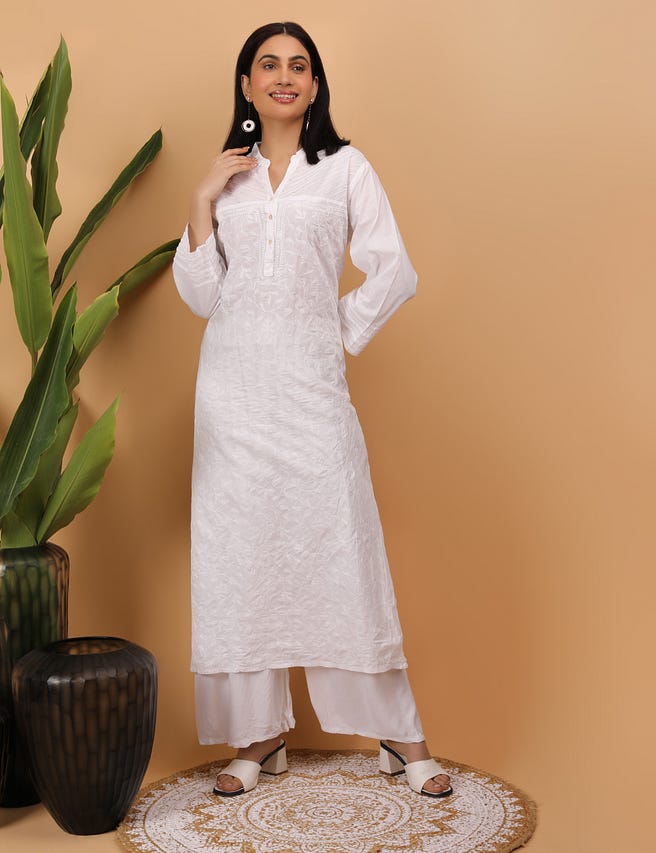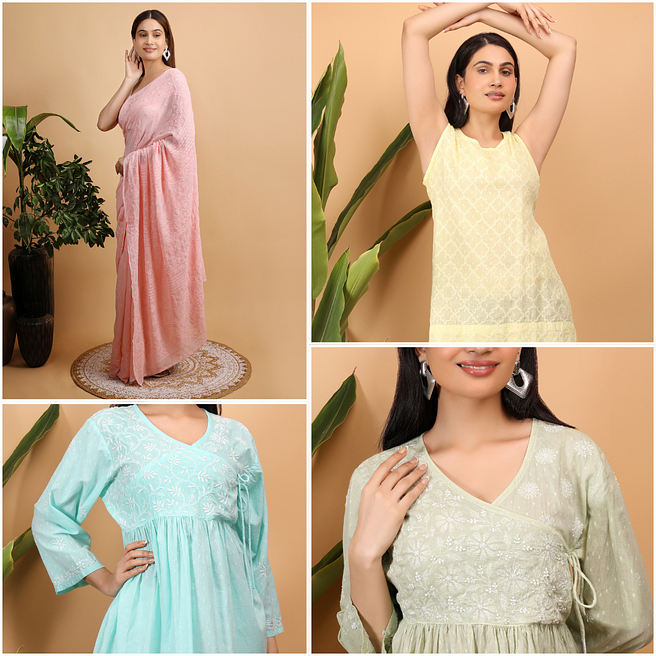
Not Just White: The Secret Colour Story of Chikankari
Share
When you hear “Chikankari,” your mind may immediately sketch delicate white embroidery on flowing white fabric. That image is iconic, no doubt — but it’s only the beginning of a far richer tapestry.
At Shwet Artistry, we celebrate not just the purity of white but the forgotten and evolving colour stories that make Chikankari a canvas of emotions, culture, and contemporary identity.
Let’s journey into the secret palette of this timeless art.
🕊 The White-on-White Soul: Chikankari’s Nawabi Roots
White on white — known as whitework — is the beating heart of traditional Chikankari. Popularized in the 18th century during Nawab Asaf-ud-Daula’s reign in Lucknow, it symbolized restraint, sophistication, and quiet luxury. In a time when brocades and jewels flaunted power, Chikankari whispered it.

Why white?
Because Chikankari was always about grace, not glitter.
It became a spiritual expression — worn in summer courtyards, in quiet reflection, in powerful silence. Even today, a white Chikankari kurta carries that legacy — more than an outfit, it’s a state of mind.

Hues from Nature: The Era of Muted Grace
While white ruled the courts, village artisans tinted their canvases with gentle, natural dyes — derived from flowers, spices, and leaves.
Pastel bases like peach, faded rose, indigo, and mint green emerged — each colour mirroring India’s seasons:
- Earthy tones for the monsoons,
- Sun washed pastels for summer ease,
- Rosewood and turmeric for ritual elegance.

During the British Raj, when new textiles and palettes arrived in India, Chikankari adapted. It embraced quiet elegance — muted yet deeply emotive.
The Bold Renaissance: Modern Chikankari Speaks Louder
The 21st century has given Chikankari a new voice — and it’s vibrant.
Designers and brands like Shwet Artistry began experimenting with:
- Bold contrast threads
- Dip-dyed ombrés
- Jewel-tone fabrics
- Metallic accents in beige, ivory, or gold threads
Today’s favourites include:
- Lemon yellow base with white embroidery
- Navy fabric kissed with pastel pink thread
- Nude beige sets with gold ivory detailing
- Peach-on-peach (one of our most loved palettes!)
These aren’t just colour trends — they’re personal expressions. Every shade is an extension of the wearer’s identity.
What Each Thread Colour Says About You
At Shwet, we believe colour isn’t decoration — it’s dialogue.
Thread Colour Mood it Carries White Tradition, purity, calm Ivory Sophistication, quiet confidence Gold Subtle opulence, festive grace Pastels Youthfulness, softness, ease Red/Black on white Power, individuality, boldness
Your Chikankari is not just worn. It speaks.
A Buyer’s Palette: How to Choose Your Chikankari Colour
Next time you browse a kurta, dupatta, or saree — don’t just match it to your lipstick.
Ask:
- Do I want to channel vintage serenity or make a modern statement?
- Does this tone amplify my skin, my mood, my moment?
- What memory or intention do I want to weave into my day?
Because in the world of Chikankari, colour isn’t random — it’s a cover page to the story you want to tell.
Shwet Artistry: Inspired by India, Crafted in Colour
We honour the traditional whites, but we also revel in colour experiments grounded in story and subtlety. Our hues are inspired by:
- Morning skies over old Lucknow
- The peach blush of mango orchards
- Faded walls of Awadhi havelis
- The timeless beauty of Indian women in every role they play
Every shade we choose reflects a piece of living history, a whisper of the present, and a touch of tomorrow.
Final Thread: A Legacy in Colour
Chikankari was never just white. It was always alive — evolving quietly with its wearers.
From courtrooms to classrooms, rituals to runways, its colours have absorbed centuries of emotion, elegance, and evolution.
So, the next time you slip into a blush pink or lemon yellow Chikankari kurta, know this:
You’re not just wearing a colour.
You’re wearing the memory of hands that stitched silence into art — and the future of a craft that’s speaking louder, in more hues than ever before.
